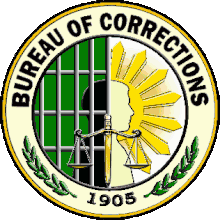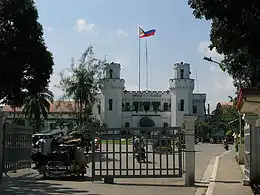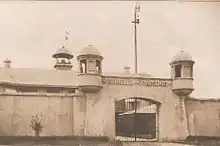| Kawanihan ng Pagawawasto | |
 The Bureau of Corrections Seal | |
| Agency overview | |
|---|---|
| Formed | 1905 |
| Jurisdiction | Government of the Philippines |
| Headquarters | New Bilibid Prison Reservation, Muntinlupa |
| Annual budget | ₱6.11 billion (2023)[1] |
| Agency executives |
|
| Parent agency | Department of Justice |
| Website | https://www.bucor.gov.ph/ |

The Bureau of Corrections (Filipino: Kawanihan ng Pagwawasto,[3] literally "Bureau of Corrections", of which it was known as the Bureau of Prisons from 1905 to 1989; abbreviated BuCor) is an agency of the Department of Justice which is charged with the custody and rehabilitation of national offenders, commonly known as Persons Deprived of Liberty or PDL, who have been sentenced to three years of imprisonment[4] or more. The agency has its headquarters in the New Bilibid Prison Reservation in Muntinlupa.[5]
Organization
It is currently headed by Director General Usec. Gregorio Catapang Jr. The bureau has 2,862 employees, 61% of whom are custodial (uniformed) officers, 33% are non-uniformed personnel and 6% are members of the medical service.[4]
Leadership
- Commander-in-Chief: President Bongbong Marcos
- Secretary of Justice (SoJ): Atty. Jesus Crispin C. Remulla
- Director-General, Bureau of Corrections (DG, BUCOR): Usec. Gregorio Catapang Jr.[6]
- Deputy Director-General for Administration (DDGA): Corrections Asec. Al I. Perreras
- Deputy Director-General for Security and Operations (DDGSO): Asec. Gil T. Torralba
- Deputy Director-General for Reformation (DDGR): Corrections C/Supt. Celso S. Bravo (OIC)
Command Leadership Structure
- The President of the Philippines as Commander-in-Chief
- The Secretary of Justice
- The Director General of the Bureau of Corrections (DG, BUCOR; with the Rank of Undersecretary donning the 4-Star rank)
- The Deputy Director General for Administration (DDGA; with the Rank of Assistant Secretary donning the 3-Star rank)
- The Deputy Director General for Security and Operations (DDGSO; with the Rank of Assistant Secretary donning the 3-Star rank)
- The Deputy Director General for Reformation (DDGR; with the Rank of Assistant Secretary donning the 3-Star rank)
National Headquarters
- Office of the Director-General
- Office of the Deputy Director-General for Administration
- Office of the Deputy Director-General for Security and Operations
- Office of the Deputy Director-General for Reformation
- BUCOR Directorial Staff
Directorates
- Directorate for Administration
- Directorate for External Relations
- Directorate for Finance and Logistics
- Directorate for Health Service
- Directorate for Planning and Management
- Directorate for Reception Diagnostic
- Directorate for Reformation
- Directorate for Security and Operations
- Directorate for Standards and Development
Support Services
- Contact Center ng Bayan
- Corrections Training School
- BUCOR Business Center
- Public Information Office
- Legal Service
- Internal Affairs Service
- Administrative Division
- Communication and Management Section
- Anti-Red Tape Act Section
- Cashier Section
- Records Section
- Human Resource Division
- General Services Division
- Planning and Statistics Division
- Management Division
- Information and Communications Technology Division
- Budget Division
- Accounting Division
- Supply Division
- Project Management and Doctrine Development Division
- Intelligence and Investigation Division
- Inmate Documents and Processing Division
- Communications and Tactical Operations Division
- Escorting Group
- Education and Training Division
- Moral and Spiritual Division
- Behavior Modification Division
- Inmate Sports and Recreation Division
- Work and Livelihood Division
- Assessment and Program Monitoring Division
- Case Management Division
- External Affairs Division
Mission
TO PROTECT THE PUBLIC BY SAFEKEEPING AND REFORMING PERSONS UNDER OUR CUSTODY ADHERING TO INTERNATIONAL STANDARDS OF CORRECTIONS SERVICE.
Mandate
SAFEKEEPING AND INSTITUTING REFORMATION PROGRAMS TO NATIONAL INMATES SENTENCED TO MORE THAN 3 YEARS.
Units
The Bureau of Corrections currently have 7 operating units located nationwide:[4]
- Correctional Institution for Women (CIW) in Mandaluyong / and The CIW Mindanao, Santo Tomas, Davao del Norte
- New Bilibid Prison in Muntinlupa
- Maximum Security Compound
- Minimum Security Compound
- Medium Security Compound
- Sablayan Prison and Penal Farm in Occidental Mindoro
- Iwahig Prison and Penal Farm in Puerto Princesa City, Palawan
- Leyte Regional Prison in Abuyog, Leyte
- San Ramon Prison and Penal Farm in Zamboanga City
- Davao Prison and Penal Farm in Braulio E. Dujali, Davao del Norte
Ranks
The following ranks are in force in the BuCor. While the Bureau forms part of the Department of Justice, its ranks follow those of the uniformed services in the Department of the Interior and Local Government.
Commissioned Officers
- Corrections Director General (Undersecretary)
- Corrections Deputy Director General for Administration (Assistant Secretary)
- Corrections Deputy Director General for Security and Operations (Assistant Secretary)
- Corrections Deputy Director General for Reformation (Assistant Secretary)
- Corrections Chief Superintendent (Brig. General)
- Corrections Senior Superintendent (Colonel)
- Corrections Superintendent (Lt. Col.)
- Corrections Chief Inspector (Major)
- Corrections Senior Inspector (Captain)
- Corrections Inspector (Lieutenant)
Non- Commissioned Officers
- Corrections Senior Officer 4 (Executive Master Sergeant)
- Corrections Senior Officer 3 (Chief Master Sergeant)
- Corrections Senior Officer 2 (Senior Master Sergeant)
- Corrections Senior Officer 1 (Master Sergeant)
- Corrections Officer 3 (Staff Sergeant)
- Corrections Officer 2 (Corporal)
- Corrections Officer 1 (Private)
Rank system until 1992
While the BuCor reports to the Department of Justice, in the past it sported a military rank system mirroring the former Integrated National Police and therefore similar to the Chilean Gendarmerie and the Italian Corpo degli Agenti di Custodia. Until 1989 officers and agents sported "Prisons" in their rank title.
| Rank |
|---|
| Prisons Colonel |
| Prisons Lieutenant Colonel |
| Prisons Major |
| Prisons Captain |
| Prisons Lieutenant |
| Prisons Sergeant |
| Prisons Corporal |
| Civil Guardsman First Class |
| Civil Guardsman |
History
Spanish colonial era

The Old Bilibid Prison which was located on Oroquieta Street in Manila was established in 1847 and by a Royal Decree formally opened on April 10, 1866. On August 31, 1870, the San Ramon Prison and Penal Farm was established in Zamboanga City for Muslim and political prisoners opposed to the rule of Spain.
American colonial era
The Iuhit penal Settlement now known as Iwahig Prison and Penal Farm was established in 1904 by the Americans in 28,072 hectares of land. The land areas expanded to 40,000 hectares in the late 1950s.[7] and expanded again to 41,007 hectares by virtue of Executive Order No. 67 issued by Governor Newton Gilbert on October 15, 1912.
The Bureau of Prisons was created under the Reorganization Act of 1905 as an agency under the Department of Commerce and Police. The Reorganization Act also re-established the San Ramon Prison in 1907 which was destroyed during the Spanish–American War in 1898. The prison was placed under the Bureau of Prisons and receive prisoners in Mindanao.[7]
The Correctional Institution for Women was founded on November 27, 1929, by virtue of Act No. 3579 as the first and only prison for women in the Philippines.[7] Later, on January 21, 1932, the bureau opened the Davao Penal Colony in Southern Mindanao.[7]
The New Bilibid Prison was established in 1935 in Muntinlupa due to the increased rate of prisoners.[7]
Contemporary era
Proclamation No. 72 issued on September 26, 1954, established the Sablayan Prison and Penal Farm in Occidental Mindoro, and the Leyte Regional Prison was established on January 16, 1973, under Proclamation No. 1101.[7]
The Administrative Code of 1987 and Proclamation No. 495, issued on November 22, 1989, changed the agency's name to the current Bureau of Corrections from Bureau of Prisons.[7]
List of Director Generals
| Director-General | Term |
|---|---|
| George M. Wolfe | 1904 – 1910 |
| M. L. Stewart | 1910 – 1914 |
| W.H. Dade | 1914 – 1920 |
| Julius W. Quillen | 1920 – 1923 |
| Ramon Victorio | 1923 – 1930 |
| Lt. Col. Paulino Santos | 1930 – 1937 |
| Maj. Eriberto B. Misa Sr. | 1937 – 1949 |
| Eustaquio Balagtas | 1949 – 1954 |
| Atty. Alfredo M. Bunye | 1954 – 1958 |
| Enrique A. Fernandez | 1958 – 1962 |
| Col. Eduardo Quintos | 1962 |
| Felix P. Amante | 1962 – 1965 |
| Col. Dominador Danan | 1965 – 1966 |
| B/Gen. Alejo Santos | 1967 – 1971 |
| B/Gen. Vicente R. Raval | 1971 – 1982 |
| Catalino Macaraig Jr. | 1979 |
| Atty. Ramon J. Liwag | 1982 |
| B/Gen. Vicente E. Eduardo | 1982 – 1986 |
| Lt. Col. Edralin Palacios | 1986 |
| B/Gen. Meliton D. Goyena | 1986 – 1991 |
| Atty. Cleto B. Senoren | 1991 |
| Eriberto B. Misa Jr. | 1991 – 1993 |
| Atty. Vicente G. Vinarao (first term) | 1994 – 1998 |
| Lt. Gen. Pedro G. Sistoza | 1998 – 2001 |
| Col. Ricardo B. Macala | 2001 – 2003 |
| Usec. Dionisio Santiago | 2003 – 2004 |
| Atty. Vicente G. Vinarao (second term) | 2004 – 2007 |
| Ricardo B. Dapat | 2007 |
| Usec. Oscar C. Calderon | 2007 – 2010 |
| Gen. Ernesto L. Diokno | 2010 – May 2011 |
| Atty. Manuel G. Co (first term) | May – August 2011 |
| Lt. Gen. Gaudencio S. Pangilinan Jr. | August 2011 – August 2012 |
| Atty. Manuel G. Co (second term) | August – November 2012 |
| Atty. Rafael Marcos Z. Ragos | November 2012 – March 2013 |
| Franklin Jesus Bucayu | March 2013 – 2015 |
| Lt. Gen. Ricardo Rainier G. Cruz | 2015 – June 2016 |
| Rolando Asuncion (OIC) | June – November 2016 |
| Atty. Benjamin Delos Santos | November 2016 – July 13, 2017 |
| Asec. Valfrie Tabian (OIC) | July 14, 2017 – April 30, 2018 |
| Usec. Ronald dela Rosa | April 30 – October 12, 2018 |
| Usec. Nicanor Faeldon | November 21, 2018 – September 5, 2019 |
| Melvin Ramon G. Buenafe (OIC) | September 6–20, 2019 |
| Usec. Gerald Q. Bantag | September 20, 2019 – October 21, 2022 |
| Gregorio Catapang Jr.[6] | October 21, 2022 – present |
Logo
.svg.png.webp)
The logo of the bureau represents the government agency's mandate, the rehabilitation of inmate. The logo focuses on the man in prison as the main concern of rehabilitation. It presents man behind bars, but who looks outwards with the hope of rejoining the free community. The 7 rays of the sun represent the 7 operating prisons and penal farms who carry out the reformation programs of the bureau. The color green symbolizes hope. The color orange is symbolic of happiness. The bar of justice represents the Philippine justice system.
Capital punishment
When the Philippines had the death penalty, male inmates condemned to death were held at New Bilibid Prison and female inmates condemned to death were held at Correctional Institution for Women (Mandaluyong).[8] The death chamber for inmates to be electrocuted was in Building 14, within the Maximum Security Compound of New Bilibid. The Bureau of Corrections (BuCor) Museum previously served as the lethal injection chamber.[9]
References
- ↑ GAA 2023 Archived March 30, 2023, at the Wayback Machine dbm.gov.ph
- ↑ Gregorio, Xave. "BuCor chief suspended as questions linger on 'middleman' in Lapid slay". Philstar.com. Archived from the original on October 21, 2022. Retrieved October 21, 2022.
- ↑ "BuCor Hymn". Bureau of Corrections Official Website. March 25, 2023. Archived from the original on March 25, 2023. Retrieved March 25, 2023.
- 1 2 3 Department of Justice, archived from the original on April 30, 2008, retrieved May 27, 2008
- ↑ "About the Bureau of Corrections Archived 2009-10-05 at the Wayback Machine." Bureau of Corrections. Retrieved on October 2, 2010. "Bureau of Corrections NBP Reservation, Muntinlupa, Philippines."
- 1 2 Fernandez, Daniza (March 24, 2023). "Gregorio Catapang permanently appointed as BuCor director general". Inquirer.net. Retrieved March 25, 2023.
- 1 2 3 4 5 6 7 Bureau of Corrections, archived from the original on April 11, 2008, retrieved May 30, 2008
- ↑ Araneta, Sandy (October 22, 2001). "1,020 death convicts await execution". The Philippine Star. Archived from the original on November 9, 2023. Retrieved May 3, 2017.
- ↑ Torres-Tupas, Tetch (July 15, 2015). "DOJ drawing list of inmates to occupy death chamber-turned-prison". Philippine Daily Inquirer. Archived from the original on December 1, 2017. Retrieved May 4, 2017.